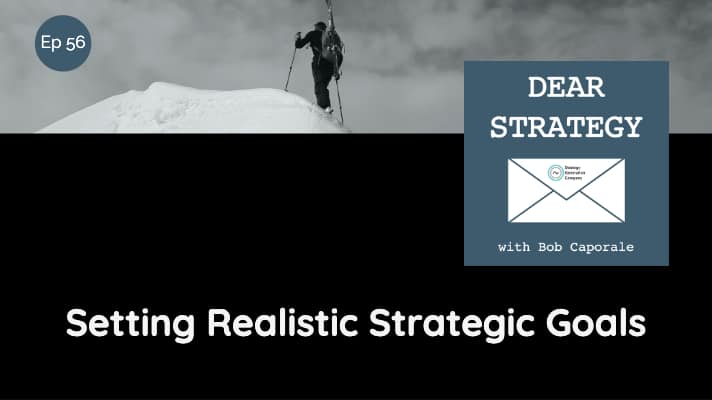Dear Strategy:
“How realistic should a strategic target be?”
Way back in Episode 009, I tackled this topic from the standpoint of managers setting unrealistic goals. What I didn’t do in that episode, however, was to answer the question of how realistic your strategic goals should actually be. So, let’s dive into that now.
To begin with, let me reiterate that there is a difference between what I refer to as a “strategic objective,” and what some people will refer to as a “strategic target.” At least in my vernacular, an objective is something that you have some plan to achieve, while a target is something that you strive for but may not know exactly how you’re going to get there. Of course, you can argue with this interpretation as there are likely many different opinions about what these two terms mean (language is funny that way). But, at least to my preference, this is the angle that I’m going to use.
If you buy into these definitions, then you might also buy into the idea that strategic “targets” can be as unrealistic as you like – and that may be true. But the larger question might be, “Is there a place for strategic targets within the context of your strategic plan?”
My answer to that question is “maybe, but probably not.” But let me be a bit clearer and, in so doing, also get around to answering the original question at hand.
I do not feel that stretch targets down to an individual metric level have any place in your strategic plan. That’s not to say that aspirational thinking shouldn’t be a part of your plan – it absolutely should. But where that shows up, at least in my process, is in your overall vision and not in your more detailed objectives.
Your vision is designed to be non-specific with respect to time or magnitude. It is meant to be a high-level aspiration that serves to guide your plan, but not completely define it.
Your objectives, on the other hand, are designed to be SMART – meaning that they should be specific, measurable, assignable, realistic, and time-based. (You can learn more about SMART criteria by clicking here). Focusing in on the “realistic” part, if your objectives don’t actually reflect the expected outcome of your plan, then what is the point of having a plan in the first place?
So, your vision is your long-term guide, your objectives are what you can realistically achieve, and your strategy is your plan to achieve them.
In my opinion, there’s no need for anything else. And here’s why…
Let’s say that your long-term vision is to obtain the leading share position in a given market. Let’s also say that you have a 5-year strategic objective to increase revenues by 50%, which will allow you to realize your vision. Finally, let’s say that you have a clear and actionable strategy that will allow you to achieve your objective. Great – so your plan all makes sense and now you can go execute against it.
Now, let’s say that you have a manager who wants you to achieve your goal sooner, and wants you to work toward a stretch target of increasing your revenue by 50% in 3 years instead of 5. Great. So, you put together a plan to achieve that number, and it turns out you will need to double your investment and hire a whole bunch of additional resources to get there – none of which your company is actually willing to do.
With all of that said, what possible purpose can it serve to put a stretch target in your plan without any real actionable strategy to achieve it? If you leave that “target” in your plan but there is actually no hope of ever hitting it, you’re likely to only annoy your audience at best, or utterly disappoint them at worst – neither of which are good options.
So, no – strategic targets have no place in your plan unless you actually have a plan to achieve them. And then they become objectives.
I know I’ve said it before in this blog, but it’s worth saying again: I’m just not a fan of throwing huge unachievable “targets” out there without any real plan to achieve them. In my opinion, that’s just a lazy way to manage – and, I can’t bring myself to get behind that type of thinking, no matter how many people I’ve worked for in the past have tried to encourage me to do just that!
With all of that said, my direct answer is that your objectives absolutely need to be realistic with respect to the strategy that you’re putting in place. That doesn’t mean they need to be “padded” – just that they need to reflect the reasonably anticipated outcomes of your overall strategic plan. Because, without that alignment, your goals will really only be hopes. And hope really doesn’t make for a very good strategy.
Listen to the podcast episode
Dear Strategy: Episode 056

###
 Bob Caporale is the founder of Strategy Generation Company, the author of Creative Strategy Generation and the host of the Dear Strategy podcast. You can learn more about his work by visiting bobcaporale.com.
Bob Caporale is the founder of Strategy Generation Company, the author of Creative Strategy Generation and the host of the Dear Strategy podcast. You can learn more about his work by visiting bobcaporale.com.






